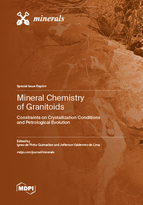Mineral Chemistry of Granitoids: Constraints on Crystallization Conditions and Petrological Evolution
A special issue of Minerals (ISSN 2075-163X). This special issue belongs to the section "Mineral Geochemistry and Geochronology".
Deadline for manuscript submissions: closed (31 October 2024) | Viewed by 21771
Special Issue Editors
Interests: petrological aspects of igneous rocks; whole rock geochemistry; mineral chemistry; geochronology; isotope geochemistry
Special Issues, Collections and Topics in MDPI journals
Interests: geochemistry and petrology of igneous rocks
Special Issues, Collections and Topics in MDPI journals
Special Issue Information
Dear Colleagues,
Mineral chemistry is an important tool for estimating crystallization parameters (temperature, pressure and oxygen fugacity) during the petrological evolution of granitic magmas, since the chemistry and redox conditions of parental magma play an important role in the composition of granitoid minerals. In addition to information about the physicochemical conditions of the magma, the chemical signature of the primary ferromagnesian phases can provide information about the magma’s nature and its affinity with the different magmatic series. Recent work has used trace element signatures in accessory minerals to estimate the source and petrological evolution of granitic magmas. This approach provides a powerful tool for the chemical study of granitoids, since it works with the chemical signatures of less mobile elements to corroborate information provided by conventional mineral chemistry.
This Special Issue aims to address the importance of the mineral chemistry of granitoids in understanding the geological history of the regions in which they are located. The study of granitoids is fundamental to understanding the crustal evolution of a region, since granitic magmatism is the main factor involved in the geochemical differentiation of the continental crust.
Prof. Dr. Ignez de Pinho Guimarães
Prof. Dr. Jefferson Valdemiro De Lima
Guest Editors
Manuscript Submission Information
Manuscripts should be submitted online at www.mdpi.com by registering and logging in to this website. Once you are registered, click here to go to the submission form. Manuscripts can be submitted until the deadline. All submissions that pass pre-check are peer-reviewed. Accepted papers will be published continuously in the journal (as soon as accepted) and will be listed together on the special issue website. Research articles, review articles as well as short communications are invited. For planned papers, a title and short abstract (about 100 words) can be sent to the Editorial Office for announcement on this website.
Submitted manuscripts should not have been published previously, nor be under consideration for publication elsewhere (except conference proceedings papers). All manuscripts are thoroughly refereed through a single-blind peer-review process. A guide for authors and other relevant information for submission of manuscripts is available on the Instructions for Authors page. Minerals is an international peer-reviewed open access monthly journal published by MDPI.
Please visit the Instructions for Authors page before submitting a manuscript. The Article Processing Charge (APC) for publication in this open access journal is 2400 CHF (Swiss Francs). Submitted papers should be well formatted and use good English. Authors may use MDPI's English editing service prior to publication or during author revisions.
Keywords
- mineral chemistry
- crystallization parameters
- geobarometry
- geothermometry
- accessory mineral trace elements
Benefits of Publishing in a Special Issue
- Ease of navigation: Grouping papers by topic helps scholars navigate broad scope journals more efficiently.
- Greater discoverability: Special Issues support the reach and impact of scientific research. Articles in Special Issues are more discoverable and cited more frequently.
- Expansion of research network: Special Issues facilitate connections among authors, fostering scientific collaborations.
- External promotion: Articles in Special Issues are often promoted through the journal's social media, increasing their visibility.
- Reprint: MDPI Books provides the opportunity to republish successful Special Issues in book format, both online and in print.
Further information on MDPI's Special Issue policies can be found here.






